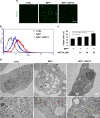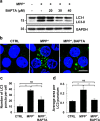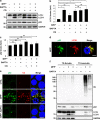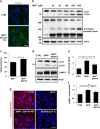Buffering of cytosolic calcium plays a neuroprotective role by preserving the autophagy-lysosome pathway during MPP+-induced neuronal death
- PMID: 31452956
- PMCID: PMC6700189
- DOI: 10.1038/s41420-019-0210-6
Buffering of cytosolic calcium plays a neuroprotective role by preserving the autophagy-lysosome pathway during MPP+-induced neuronal death
Abstract
Parkinson's disease (PD) is a chronic neurodegenerative disease with no cure. Calbindin, a Ca2+-buffering protein, has been suggested to have a neuroprotective effect in the brain tissues of PD patients and in experimental models of PD. However, the underlying mechanisms remain elusive. Here, we report that in 1-methyl-4-phenylpyridinium (MPP+)-induced culture models of PD, the buffering of cytosolic Ca2+ by calbindin-D28 overexpression or treatment with a chemical Ca2+ chelator reversed impaired autophagic flux, protecting cells against MPP+-mediated neurotoxicity. When cytosolic Ca2+ overload caused by MPP+ was ameliorated, the MPP+-induced accumulation of autophagosomes decreased and the autophagic flux significantly increased. In addition, the accumulation of damaged mitochondria and p62-positive ubiquitinated protein aggregates, following MPP+ intoxication, was alleviated by cytosolic Ca2+ buffering. We showed that MPP+ treatment suppressed autophagic degradation via raising the lysosomal pH and therefore reducing cytosolic Ca2+ elevation restored the lysosomal pH acidity and normal autophagic flux. These results support the notion that functional lysosomes are required for Ca2+-mediated cell protection against MPP+-mediated neurotoxicity. Thus, our data suggest a novel process in which the modulation of Ca2+ confers neuroprotection via the autophagy-lysosome pathway. This may have implications for the pathogenesis and future therapeutic targets of PD.
Keywords: Cell death in the nervous system; Neurological disorders.
Conflict of interest statement
Conflict of interestThe authors declare that they have no conflict of interest.
Figures






Similar articles
-
Mild MPP+ exposure impairs autophagic degradation through a novel lysosomal acidity-independent mechanism.J Neurochem. 2016 Oct;139(2):294-308. doi: 10.1111/jnc.13700. Epub 2016 Oct 3. J Neurochem. 2016. PMID: 27309572
-
Artemisia Leaf Extract protects against neuron toxicity by TRPML1 activation and promoting autophagy/mitophagy clearance in both in vitro and in vivo models of MPP+/MPTP-induced Parkinson's disease.Phytomedicine. 2022 Sep;104:154250. doi: 10.1016/j.phymed.2022.154250. Epub 2022 Jun 15. Phytomedicine. 2022. PMID: 35752074
-
The Degradation of TMEM166 by Autophagy Promotes AMPK Activation to Protect SH-SY5Y Cells Exposed to MPP.Cells. 2022 Aug 30;11(17):2706. doi: 10.3390/cells11172706. Cells. 2022. PMID: 36078115 Free PMC article.
-
Paeoniflorin, a potent natural compound, protects PC12 cells from MPP+ and acidic damage via autophagic pathway.J Ethnopharmacol. 2010 Aug 19;131(1):122-9. doi: 10.1016/j.jep.2010.06.009. Epub 2010 Jun 15. J Ethnopharmacol. 2010. PMID: 20558269
-
The regulation of autophagy by calcium signals: Do we have a consensus?Cell Calcium. 2018 Mar;70:32-46. doi: 10.1016/j.ceca.2017.08.005. Epub 2017 Aug 19. Cell Calcium. 2018. PMID: 28847414 Review.
Cited by
-
The evolution of organellar calcium mapping technologies.Cell Calcium. 2022 Dec;108:102658. doi: 10.1016/j.ceca.2022.102658. Epub 2022 Oct 11. Cell Calcium. 2022. PMID: 36274564 Free PMC article. Review.
-
Acquisition of neurodegenerative features in isogenic OPTN(E50K) human stem cell-derived retinal ganglion cells associated with autophagy disruption and mTORC1 signaling reduction.Acta Neuropathol Commun. 2024 Oct 18;12(1):164. doi: 10.1186/s40478-024-01872-2. Acta Neuropathol Commun. 2024. PMID: 39425218 Free PMC article.
-
INTERSPECIES ORGANOIDS REVEAL HUMAN-SPECIFIC MOLECULAR FEATURES OF DOPAMINERGIC NEURON DEVELOPMENT AND VULNERABILITY.bioRxiv [Preprint]. 2024 Nov 15:2024.11.14.623592. doi: 10.1101/2024.11.14.623592. bioRxiv. 2024. PMID: 39605599 Free PMC article. Preprint.
-
Upregulation of Ca2+-binding proteins contributes to VTA dopamine neuron survival in the early phases of Alzheimer's disease in Tg2576 mice.Mol Neurodegener. 2022 Nov 25;17(1):76. doi: 10.1186/s13024-022-00580-6. Mol Neurodegener. 2022. PMID: 36434727 Free PMC article.
-
Effects of Apamin on MPP+-Induced Calcium Overload and Neurotoxicity by Targeting CaMKII/ERK/p65/STAT3 Signaling Pathways in Dopaminergic Neuronal Cells.Int J Mol Sci. 2022 Dec 3;23(23):15255. doi: 10.3390/ijms232315255. Int J Mol Sci. 2022. PMID: 36499581 Free PMC article.
References
LinkOut - more resources
Full Text Sources
Miscellaneous

